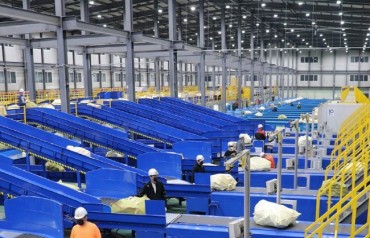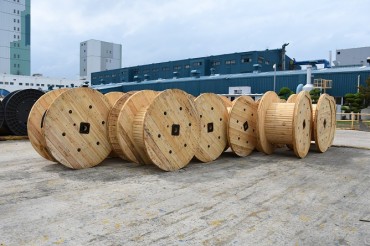
The Fukushima Daiichi nuclear power plant, accompanied by its storage tanks for contaminated water, presents a notable sight. (Image courtesy of Yonhap)
SEOUL, May 22 (Korea Bizwire) —Members of a South Korean inspection team tasked with scrutinizing the discharge process of contaminated water from Japan’s Fukushima nuclear plant embarked on their journey to Japan on Sunday morning.
The team, comprising 21 members, consisted of nuclear and radiation experts from the Korea Atomic Energy Safety Institute (KINS), but notably excluded any private experts.
To the public’s dismay, the list of experts accompanying the delegation was not disclosed, and South Korean media representatives were reportedly denied permission to join the group due to opposition from the Japanese side.
In a parallel development, the Japanese government has referred to the South Korean inspection process as a mere “briefing session,” raising concerns over the level of access that will be granted.
According to reports, the team will only be permitted to visit locations pre-determined by Japan and will not be allowed to collect samples.

During the Group of Seven (G7) summit held in Hiroshima, Japan, on May 19, officials from the reconstruction agency showcased sake and food products from regions impacted by the Great East Japan Earthquake, including Fukushima Prefecture, at a designated media center. (Image courtesy of Yonhap)
Furthermore, the primary aim of the inspection team’s visit is not to obtain precise measurements of radioactive contamination through direct collection of local contaminated water.
Rather, their objective is to assess the adequacy and transparency of the monitoring system during the discharge process. However, this approach has sparked criticism and skepticism among political and academic circles.
 Seo Kyun-ryeol, a professor emeritus at Seoul National University’s Department of Nuclear and Atomic Engineering, has consistently questioned Japan’s decision to discharge contaminated water from the Fukushima reactors.
Seo Kyun-ryeol, a professor emeritus at Seoul National University’s Department of Nuclear and Atomic Engineering, has consistently questioned Japan’s decision to discharge contaminated water from the Fukushima reactors.
He highlighted the absence of standardized protocols for verifying the safety of the contaminated water, emphasizing the necessity of a more comprehensive and rigorous verification process.
A former vice president of the Korean Nuclear Society, Seo studied nuclear engineering at Seoul National University and earned his PhD at MIT. He has worked at the French Electric Power Agency, Westinghouse Electric, and the Korea Atomic Energy Research Institute.
Seo warned of the ongoing issue of contaminated water and groundwater emissions resulting from the damaged reactors and melted nuclear fuel. He argued that the release of highly toxic substances would intensify once the nuclear fuel undergoes re-salting.
Drawing a comparison with the Chernobyl disaster, where the site was sealed with concrete to prevent groundwater contamination, Seo expressed concerns about the exposed conditions at the Fukushima plant. Notably, he criticized the Japanese government for its silence on this matter.
Seo has long advocated for the immediate sealing of the Fukushima disaster site with concrete and the prevention of groundwater leakage. He firmly believes that these proactive measures should have been implemented from the outset, averting the need to address the issue after the fact.
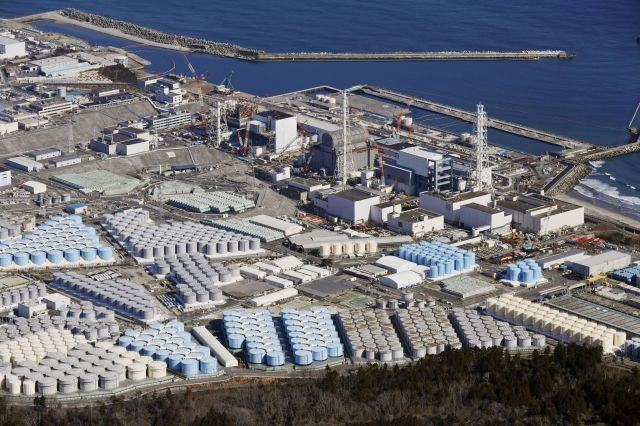
The Fukushima Daiichi nuclear power plant, accompanied by its storage tanks for contaminated water, presents a notable sight. (Image courtesy of Yonhap)
Opposition lawmakers in South Korea have raised questions regarding the inspection team’s methodology for verifying contaminated water at the plant. They criticize the limited scope of the Fukushima site inspection, which only allows the team to receive one-sided explanations from Japan and promotional materials.
This arrangement could potentially provide the Japanese government with an opportunity to claim that there are no problems with the contaminated water treatment process.
Additionally, reports suggest that the inspection team was not afforded an adequate verification period, as the Japanese government imposed strict time constraints, citing the possibility of radiation exposure.
Meanwhile, the ruling party in Korea, which seems to align with the Japanese government’s stance, is actively promoting the notion that the contaminated water from the Fukushima nuclear plant is safe.
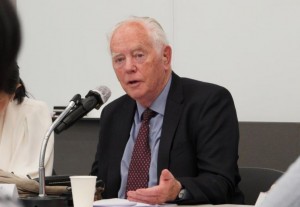 Last Friday, the party invited Wade Allison, an emeritus professor at Oxford University in the United Kingdom, to deliver a talk titled “Fear, Myths and Fukushima” at the National Assembly.
Last Friday, the party invited Wade Allison, an emeritus professor at Oxford University in the United Kingdom, to deliver a talk titled “Fear, Myths and Fukushima” at the National Assembly.
Allison controversially asserted that he could consume a liter of diluted Fukushima water, emphasizing that tritium, as a form of hydrogen, does not accumulate in the body. However, Seo countered this argument, saying, “while tritium is flushed out of the body, it can interact with blood once it enters the body.”
Seo jokingly argued that if Fukushima’s contaminated water was safe, it should be used as drinking water, not discharged, as Allison argued. “If it’s so safe, it’s too wasteful to be used for industrial and agricultural purposes,” he said, adding, “Let’s not throw it away, let’s connect it directly to the Tokyo water supply (for drinking).”
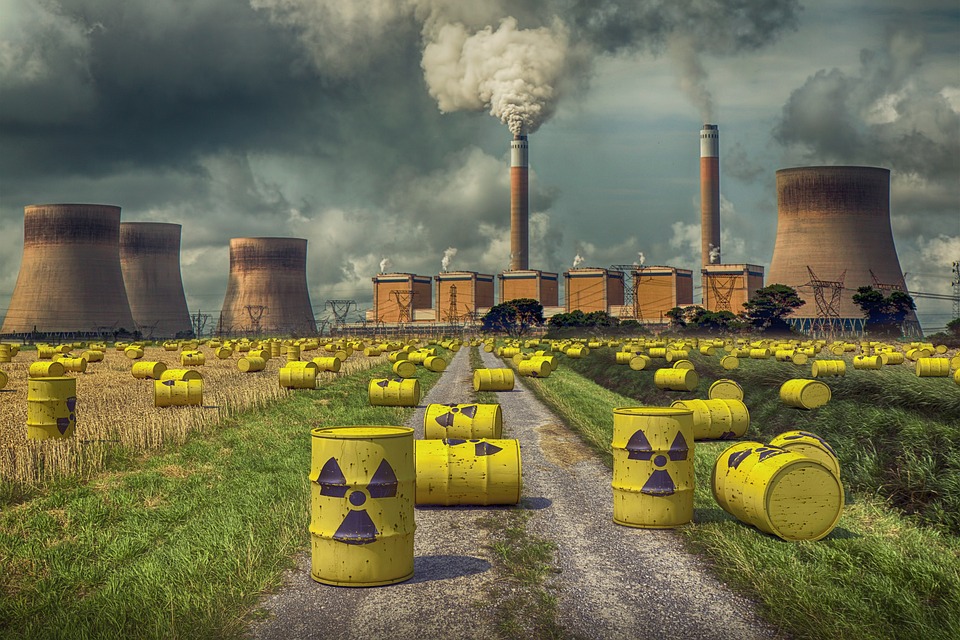
“The human body consists of over 60% water, and tritium is a form of water that can easily mix with it,” Prof. Seo explained. “When it interacts with living organisms, particularly white blood cells in the bloodstream, it generates a mild electrical charge. Although it is a weak form of radiation, it can still have damaging effects on cells.” “Given that chromosomes are twisted in a double-helix structure, even this weak charge can lead to their breakage,” he continued. “While tritium can be eliminated from the body, it remains active for up to 12 days before excretion.” (Image courtesy of Pixabay)
He highlighted the far higher radioactivity of cesium, strontium, and plutonium compared to tritium, emphasizing the hazards associated with “cesium-strontium-plutonium,” which emit gamma rays and beta rays, possessing significant energy.
In a recent radio interview with public broadcaster MBC, Seo explained that these substances not only enter the bloodstream but also permeate the muscles, bones, and brain, leading to the development of solid cancers and tumors. He cited haenyeo, female divers in South Korea, as an example of direct harm.
Seo noted that despite wearing diving suits instead of protective suits, haenyeo are still vulnerable to gamma ray neutrons, which can penetrate through their clothing. He stressed the necessity of wearing lead suits for adequate protection, highlighting the potential consequences of prolonged exposure.
As the uncertainty surrounding the discharge of contaminated water from the Fukushima Daiichi nuclear power plant grows, South Koreans, known for their significant seafood consumption, are increasingly seeking reliable resources addressing the actual risks associated with the situation.
In this context, renewed attention has been drawn to the case of a Japanese television presenter who, more than a decade ago, hosted a program promoting Fukushima produce and was subsequently diagnosed with acute lymphocytic leukemia.

Approximately 150 individuals, comprising fishermen and haenyeo, gathered at Dodoo Port in Jeju City on Monday morning to protest against the release of polluted water from Japan’s nuclear power plant. (Image courtesy of Yonhap)
Reports from major Japanese media outlets, including the Jiji News Agency, indicated then that Norikazu Otsuka, the presenter in question, received the diagnosis during the period when he supported Fukushima produce sales, which were suffering due to radiation concerns.
Although Otsuka underwent treatment and returned to work, his leukemia relapsed in 2013, necessitating hospitalization. By the end of his radio program in 2017, he reportedly remained unable to resume his professional activities.
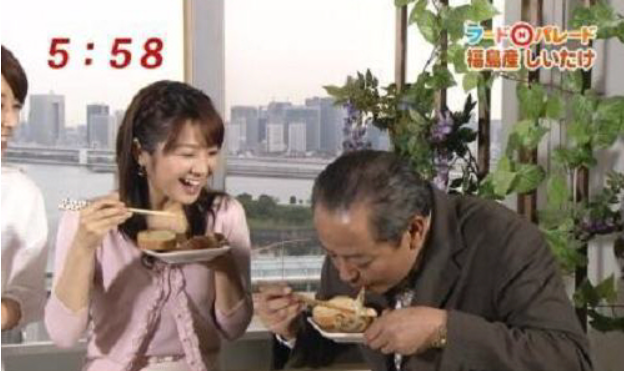
During the broadcast, Norikazu Otsuka, the broadcaster, can be seen sampling food made with Fukushima produce. (Fuji TV screen capture)
Around the same time, Vice Chief Cabinet Secretary Yasuhiro Sonoda garnered attention when he publicly drank water from a well adjacent to the Fukushima Daiichi plant.
However, recent observations suggest that Sonoda has not been seen in public, and his social media accounts have been suspended, fueling speculation about his health following the performance.
Sonoda had claimed that the water he drank had been “decontaminated to a reassuring level.” However, video footage on YouTube captured his hands trembling during the act, a detail highlighted by The Guardian, a British newspaper.

In 2011, Yasuhiro Sonoda, the former cabinet secretary for political affairs, was captured drinking treated contaminated water. Since retiring from politics in 2015, he has not been involved in any public activities. (Captured from a BBC article)
While both the South Korean and Japanese governments assert that the discharge of contaminated water from Fukushima is not a significant concern, South Korean fishermen are already expressing worries.
Reports have emerged of sashimi restaurants on Jeju Island closing down, reflecting public anxiety over the safety of the seafood they consume.
Simultaneously, the Japanese government announced on Sunday that sake from Fukushima was served at the dinner table during the Group of Seven (G7) summit held in Hiroshima.
This move aims to demonstrate to the international community that there are no safety issues associated with consuming food from Fukushima, reinforcing the message that the discharge of contaminated water poses no problem.
However, Japan’s promotion of the safety of Fukushima agricultural products at the G7 summit has triggered controversy, with a separate facility set up to showcase these items.
Presently, South Korea has imposed a ban on all seafood imports from Fukushima and eight neighboring prefectures, including Gunma and Tochigi.
Nevertheless, following the visit by the South Korean inspection team to the Fukushima plant, it is increasingly likely that Japan will push for the ban to be lifted, citing South Korea’s confirmation that no issues arose during the assessment.
Jerry M. Kim (jerry_kim@koreabizwire.com)




